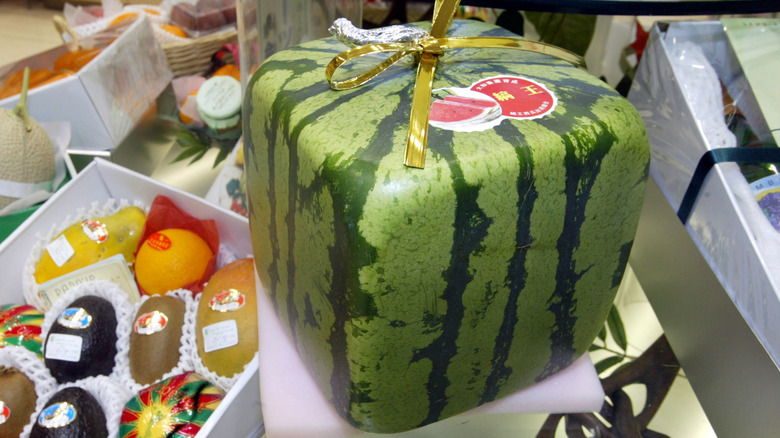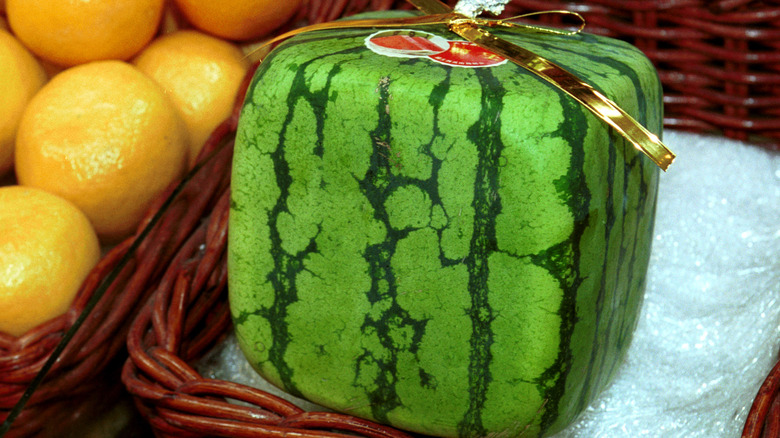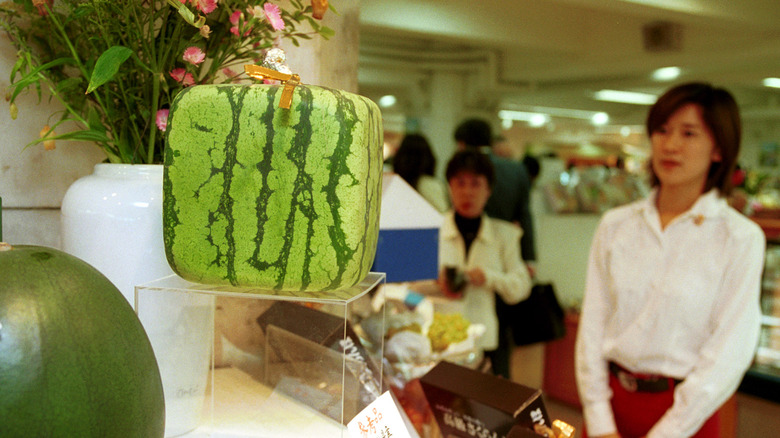Japan's Square Watermelons Are Pricey For A Reason
Let's be honest, round watermelons are a bit inconvenient. Their shape makes them prone to rolling, so you have to keep an eye on them. One little bump off the counter, and you could end up with a watermelon explosion. Not to mention, if you want to chill them in the fridge, they never quite sit right, taking up awkward space. By the way, instead of chilling watermelon, try freezing it for delicious watermelon shaved ice.
To solve this problem, Japan, a country known for adopting many cool innovations like advanced bidet toilets in 80% of households, started growing square watermelons in the late 1970s. These unique melons are grown each year between June and July in the city of Zentsuji. However, they're not cheap. To get one, you need to visit Japan and pay $100 minimum. In expensive cities like Tokyo, it's more common to pay around $200, and prices can reach as high as $500. You can also apparently get one shipped, though it may set you back $800, and we couldn't find any places offering them for sale. Considering only 300 of these square watermelons are produced annually, and as few as 70 during a bad harvest year, the cost starts to make sense.
How are they made square?
While you might have imagined a special square watermelon seed coveted by Japanese farmers, there is actually no such thing (and the legend about growing a watermelon in your belly by eating the seed is a myth too). Watermelons are made square by growing them in carefully designed molds. Thesy are very strong to prevent the watermelon from breaking through and transparent to allow sunlight to reach the fruit for its distinct green color. The end product measures exactly 18 centimeters x 18 centimeters, perfectly fitting the shelves in Japanese refrigerators. Only the best watermelons that meet quality standards, including specific weight requirements and having uniformly aligned stripes, can be sold.
From the time the watermelon is placed inside the growing box to when it's harvested is only 10 days. The watermelons are picked while they're immature, so they'll last as long as possible. Unfortunately, this means they don't taste very good. Think of the bland, hard texture of an unripe watermelon. Previously, they were grown to taste like the juicy summer watermelons we all know and love, but these only had about a week of shelf life.
Square watermelon farming is a meticulous process with farmers checking each watermelon 2-3 times a day, and even a small scratch can result in a defect that doubles the fruit's size. This made the cost of producing them for short-term consumption impractical. With the current method of producing them, the watermelons last for up to six months.
Why pay so much for a watermelon you can't eat?
Despite not being edible, square watermelons still have a special place in Japanese culture as esteemed decorative objects. You're most likely to see them in fancy five-star hotels and upscale department stores, where they are used to draw customers in and showcase the establishment's opulence.
Each square watermelon comes with its own cushion and soft packing material for protection, along with a guide for decorating it with a ribbon. These watermelons are meant to be marveled at for their whimsical, fun appearance and the incredible craftsmanship behind them. Farmers often describe them as a way to "blow away the summer heat," visually reminding viewers of cooling off with a fresh watermelon slice and instantly uplifting their spirits (via Japanese Food Guide).
Gifting a square watermelon is the ultimate gesture of extravagance and appreciation in Japan. Gift-giving is a cherished tradition in Japanese culture, observed several times each year to convey respect and gratitude. Among the many gift options, fruit is a popular choice. In fact, you can find flawlessly packed, picture-perfect fruit in almost every market and department store. They even have stunningly arranged fruit baskets that are a feast for the eyes. So, if you ever want to make a grand statement, why not go for a square watermelon?


